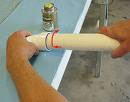How to Design Piping Systems – Concentration and Visualization.
Concentration and visualization go hand to hand. How important is concentration and visualization on subject of how to design piping system? Is your first question right, I would also have the same query popping up in my mind if I get in to your shoes and observe the scenario from your window.
Honestly and very, very honestly a passionate piping designer should be so fanatical that colleagues looking at him should feel that he/she has driven crazy. Well here I would like to share my practical experience with you, this was in my office once I was routing a 36” line I was in to my deep visualization, observing the route of my 36” line I was in stagnant my eyes were looking straight and unfortunately the other side on me was beautiful newly recruited co-partner Ms Alana (name changed).
Alana was under an impression that I was lusty about her but seriously I was observing the dramatic routing of my 36” line and its branches, after a short while she saw me walking a few steps to right holding my selves looking up in the air at short intervals with both my hands in my pocket, well by now she was quite sure that I was mentally psychic. But gradually and almost immediately she was acknowledged about my intensity of concentration and visualization.
But ever since the advanced technology has introduced innumerable solutions and software’s which neither consume less time, paper and paper work but also make the piping design an easy task, for example PDMS.
How to Design Piping Systems – Plot Plans (PP)
PP plays a vital role from the very initial stage after winning an engineering contract. The PP’s are usually generated in a very speedy pace and also contains very restricted information. This key deliverable is thus initially generated with only tentatively positioned equipments, pipe racks with dimensions, location and sizes, the only purpose of which is to get a rough idea of the plant.
Further the constructability is then assessed and this deliverable is released for the client’s approval. Subsequently the copies are circulated to departments of Engineering, Planning, Construction, Operations, Cost and Estimation and finally Purchase as symbolic orientation and acts as a universal document utilized by the inter-disciplines including the client.
How to Design Piping Systems – Plot Plans Development
PP’s in the primary phase are developed very proficiently depending on the project design specifications with estimated sizes of equipments and Process Flow Diagram’s (PFD) to verify structural model and virtual equipment arrangement.
All the huge diameter piping headers and expensive piping such as alloy piping and the major pipe racks are illustrated as compelled by PFD’s. Usually high costing pipes are mentioned in different colors, whereas the process piping connected to the equipments are highlighted in separate colors to identify the costing with ease.
As PP’s are the vivacious document sprouting through the entire life of the plant, it is described in different names in different stages of progress in a process plant. Hence the list of PP’s with respect to level of progress follows:-
· Proposed PP: - Specially developed for bidding the project.
· For Approval PP: - Released for client’s approval with the information of space availability, roads, surrounding occupied areas, highlighting the fouling information.
· Overall PP: - Describing the utility, storage area, unloading and loading areas of a particular process plant etc.
How to Design Piping Systems – Plot Plans Major role
· PP’s are necessary for achieving Safety permits and verifying ecological or environmental and employee’s safety. These are the most important documents used in evaluating fire protection.
· PP’s are the major references to measure completion of project during the courses of construction, PP’s thus help in terms of payments after partial completion of project.
· Prevailing winds shall also be taken in to consideration subjected to towers high structures and various equipments at higher elevations.
· Though the directions of winds are always invariable throughout the year still it has to be taken in to consideration for the safety of adjacent residential or commercial areas.
· High elevated structure or towers are mostly considered if the plant is located near the airport.
· Climatic conditions play a vital role in designing a PP for extremely hot deserts wherein the provision of sun shades for the maintenance and operators are mandatory.
· On the other hand the structural shades with a provision of enclosed heating shelters shall be considered at extreme low temperature areas. For example Snow or ice.
Design Piping System
Design Piping System | pipingdesigners
Pipes of the design piping systems are the nervous system of a particular Process or Thermal plant.It is the best source of conveying fluids, liquid mixtures of water and an insoluble solid material such as cement or clay, solids, air etc. under myri
Visit >>>http://pvcpipefitting.blogspot.com/
Tag: npt pipe fittings, pipe fittings valves, poly pipe fittings, bsp pipe fittings, polyethylene pipe fittings, high pressure pipe fittings, stainless steel pipe, stainless steel fittings, sanitary pipe fittings, pex pipe fittings
Source: http://afzalshaikh.hubpages.com/hub/afzalshaikh





